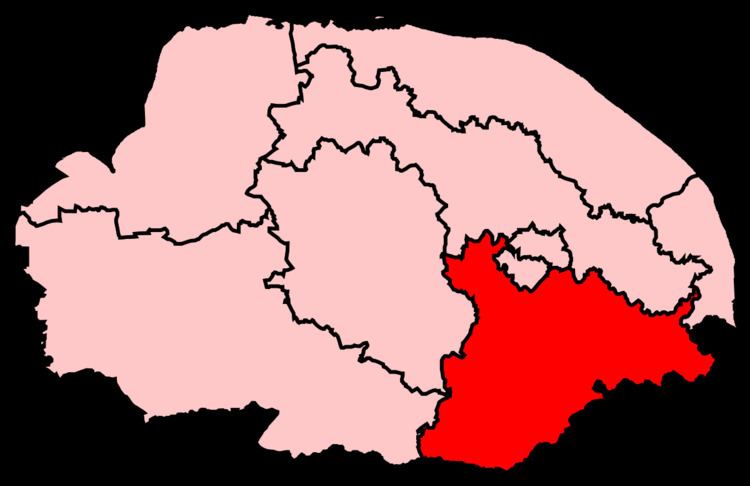County Norfolk Created 1868 | Electorate 77,316 (December 2010) European Parliament constituency East of England Number of members 1 | |
 | ||
South Norfolk is a constituency represented in the House of Commons of the UK Parliament since 2001 by Richard Bacon, a Conservative.
Contents
Boundaries
Following the Reform Act 1832 the historic county constituency Norfolk was for the first time split into two, two member, county divisions - East Norfolk and West Norfolk.
The Reform Act 1867 led, the following year, to the county's redistribution into three, two member, county divisions. The three divisions, from the United Kingdom general election, 1868 became this one, the North and modified Western division.
The Southern division had its place of election at Norwich. This was the same place of election as the abolished Eastern division. In 1868 the same two MPs who had sat for East Norfolk before its end were re-elected from this constituency.
Under the provisions of the Redistribution of Seats Act 1885, single member constituencies became the norm and greater equalisation in electorate occurred. In Norfolk the three, two member, county divisions were changed to six single member seats. These were this constituency, a revived East Norfolk, Mid Norfolk, North Norfolk, North West Norfolk and South West Norfolk.
In the 1885 redistribution this constituency consisted of the Sessional Divisions of Depwade, Diss, Earsham, Loddon and Clavering, and Swainsthorpe. It bordered Mid Norfolk to the west, the borough constituency of Norwich and East Norfolk to the north, the borough of Great Yarmouth and the Suffolk constituency of Lowestoft to the east and another Suffolk division, Eye, to the south.
The Southern division was very agricultural in character. The largest town was Diss, which had a population of fewer than 4,000 people in 1900.
From the Representation of the People Act 1918, the constituency comprised the local government divisions:
1918-1950: The Urban District of Diss, the Rural Districts of Depwade, Forehoe, Henstead, and Wayland, and part of the Rural District of Thetford.
1950-1974: The Municipal Borough of Thetford, the Urban Districts of Diss and Wymondham, and the Rural Districts of Depwade, Loddon, and Wayland. These areas combined to produce a somewhat more urban constituency than before.
1974-1983: The Municipal Borough of Thetford, the Urban Districts of Diss and Wymondham, and the Rural Districts of Depwade, Forehoe and Henstead, Loddon, and Wayland. This was the last redistribution before a major reorganisation of local government, which amalgamated many of the smaller local authorities.
1983-1997: A further reduction of area in the 1983 redistribution meant that the seat now consisted of the entire District of South Norfolk. The other part of the old seat (Thetford and Wayland) was transferred to the redrawn Norfolk South West constituency.
1997-2010: Continuing population growth led to another reduction in the constituency's territory. It comprised the District of South Norfolk except the wards of Cringleford and Colney, and New Costessey (which were now in Norwich South).
2010-present: The Boundary Commission for England reduced the wide part of the District of South Norfolk comprising the constituency: eight wards became part of other seats. The seat now has electoral wards:
Beck Vale, Bressingham and Burston, Brooke, Bunwell, Chedgrave and Thurton, Cringleford, Dickleburgh, Diss, Ditchingham and Broome, Earsham, Easton, Forncett, Gillingham, Harleston, Hempnall, Hethersett, Loddon, Mulbarton, Newton Flotman, Old Costessey, Poringland with the Framinghams, Rockland, Roydon, Scole, Stoke Holy Cross, Stratton, Tasburgh, and Thurlton.
MPs since 1885 (one seat)
Notes:-
